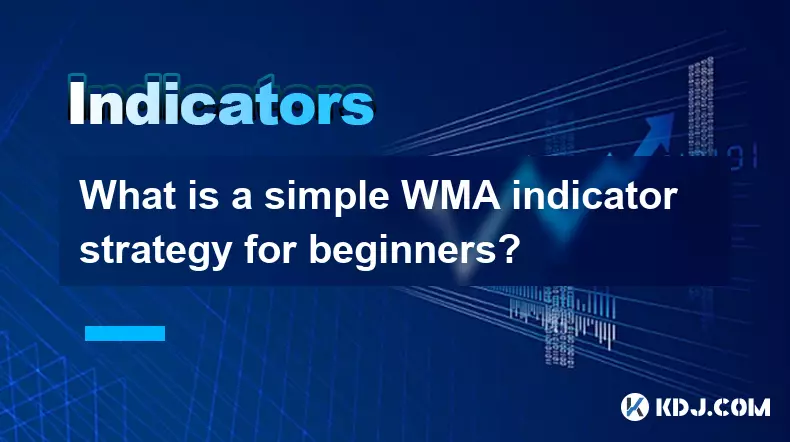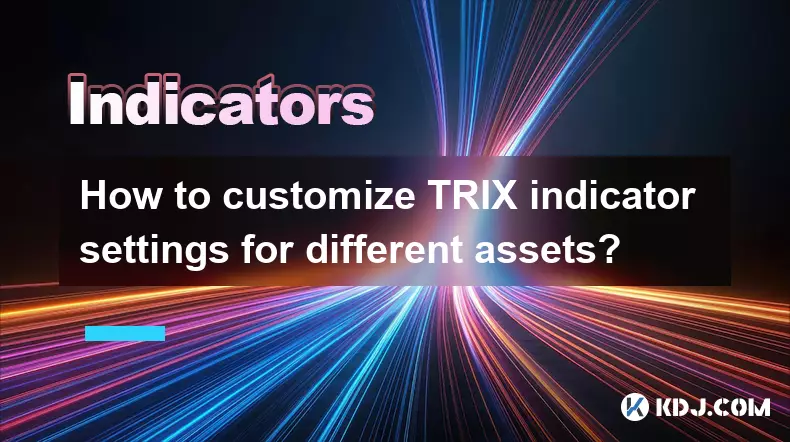-
 bitcoin
bitcoin $100977.009184 USD
-2.05% -
 ethereum
ethereum $3282.009150 USD
-3.23% -
 tether
tether $0.999813 USD
-0.02% -
 xrp
xrp $2.208254 USD
-4.89% -
 bnb
bnb $951.411089 USD
0.55% -
 solana
solana $155.761205 USD
-2.84% -
 usd-coin
usd-coin $1.000217 USD
0.02% -
 tron
tron $0.284475 USD
-1.28% -
 dogecoin
dogecoin $0.162363 USD
-1.53% -
 cardano
cardano $0.533988 USD
-0.47% -
 hyperliquid
hyperliquid $39.174339 USD
-3.22% -
 chainlink
chainlink $14.724828 USD
-1.16% -
 bitcoin-cash
bitcoin-cash $477.297986 USD
-1.28% -
 zcash
zcash $554.227426 USD
17.30% -
 ethena-usde
ethena-usde $0.998995 USD
-0.03%
What is a simple WMA indicator strategy for beginners?
The Weighted Moving Average (WMA) emphasizes recent prices, making it ideal for spotting early trends in volatile crypto markets like Bitcoin and Ethereum.
Nov 06, 2025 at 10:25 am

Understanding the Weighted Moving Average (WMA)
1. The Weighted Moving Average (WMA) assigns greater importance to recent price data, making it more responsive to new information compared to a Simple Moving Average (SMA). This sensitivity helps traders identify trend changes earlier in volatile markets such as cryptocurrency.
2. In the context of digital assets, where price swings can be rapid and pronounced, the WMA acts as a dynamic support or resistance level. When the current price is above the WMA line, it often signals bullish momentum; when below, bearish sentiment may dominate.
3. Calculation of the WMA involves multiplying each closing price by a weighting factor, with the most recent prices receiving higher weights. These values are then summed and divided by the sum of the weightings. For example, in a 5-period WMA, the most recent close gets a weight of 5, the prior day 4, and so on down to 1.
4. Because it emphasizes newer data, the WMA tends to follow prices more closely than other moving averages. This makes it particularly useful for short-term trading strategies in fast-moving environments like Bitcoin or Ethereum markets.
5. Traders often use periods such as 10, 20, or 50 when applying WMA on hourly or daily charts. Shorter periods increase sensitivity, while longer ones smooth out noise but may lag during sharp moves.
Entry Signals Using WMA Crossovers
1. A basic yet effective strategy involves monitoring the relationship between price and the WMA line. When the market price crosses above the WMA, it generates a potential buy signal, suggesting upward momentum is building.
2. Conversely, when the price drops below the WMA, it indicates weakening demand and could prompt an exit or short entry, depending on the trader’s approach. These crossovers work best when confirmed by volume spikes or candlestick patterns.
3. Some traders combine two WMA lines—a shorter-term and a longer-term—to create crossover signals between the indicators themselves. For instance, a 10-period WMA crossing above a 30-period WMA suggests bullish acceleration.
4. False signals can occur during consolidation phases, so filtering entries with additional tools like RSI or MACD improves reliability. In sideways markets, frequent whipsaws may lead to losses if used in isolation.
5. On crypto charts, where 24/7 trading amplifies volatility, using WMA on higher timeframes like 4-hour or daily reduces noise and increases the significance of each signal.
Risk Management and Exit Tactics
1. Position sizing should align with account risk parameters—typically no more than 1-2% per trade for beginners. Even strong WMA signals can fail, especially during unexpected news events or exchange outages common in the crypto space.
2. Stop-loss orders can be placed just below the WMA line in long positions or above it in shorts. This ensures exits if the trend reverses suddenly, protecting capital from large drawdowns.
3. Trailing stops based on WMA movement allow profits to run while locking in gains. As the WMA rises in an uptrend, adjusting the stop upward maintains exposure to continued momentum.
4. Take-profit levels might coincide with key resistance zones or Fibonacci extensions. Combining these with WMA behavior at historical turning points enhances precision.
5. Overtrading is a common pitfall. Waiting for clear WMA breaks accompanied by strong volume prevents impulsive decisions driven by FOMO or fear during extreme market swings.
Frequently Asked Questions
What timeframe works best for a beginner using WMA in crypto trading? The 4-hour and daily charts provide a balanced view, minimizing market noise while capturing meaningful trends. New traders benefit from fewer signals, allowing time to analyze each setup thoroughly.
Can the WMA be combined with volume indicators effectively? Yes, pairing WMA with on-balance volume (OBV) or volume-weighted average price (VWAP) confirms whether price movements are supported by actual buying or selling pressure, increasing signal validity.
Is the WMA suitable for all cryptocurrencies? It performs well on major coins like BTC and ETH due to their liquidity and consistent trading activity. Low-cap altcoins with erratic volume may generate unreliable WMA signals.
How does WMA differ from EMA in practical trading scenarios? While both prioritize recent prices, EMA applies exponential smoothing and reacts faster than WMA. WMA's linear weighting offers slightly less sensitivity, which some traders prefer to avoid premature entries.
Disclaimer:info@kdj.com
The information provided is not trading advice. kdj.com does not assume any responsibility for any investments made based on the information provided in this article. Cryptocurrencies are highly volatile and it is highly recommended that you invest with caution after thorough research!
If you believe that the content used on this website infringes your copyright, please contact us immediately (info@kdj.com) and we will delete it promptly.
- BlockDAG, Avalanche, Dogecoin: Crypto's Leading Trio in 2025
- 2025-11-07 22:05:01
- Layer 2 Coins: Will There Be a Potential Explosion by 2026?
- 2025-11-07 16:50:02
- Filecoin, ICP, and the AI Infrastructure Renaissance: Is History Repeating?
- 2025-11-07 16:50:02
- Bitcoin's Wild Ride: Surges, Zeros, and the Search for Stability
- 2025-11-07 17:05:01
- XRP, Bitcoin, and the Rally: What's the Deal, New York?
- 2025-11-07 17:25:01
- Filecoin, DePIN, and a Technical Breakout: What's the Buzz?
- 2025-11-07 17:05:01
Related knowledge

How do professional traders use the TRIX indicator?
Nov 06,2025 at 04:40pm
Understanding the TRIX Indicator in Crypto TradingThe TRIX (Triple Exponential Average) indicator is a momentum oscillator used by professional trader...

Can I use the TRIX indicator on my mobile trading app?
Nov 07,2025 at 07:40pm
The TRIX indicator, a momentum oscillator designed to filter out short-term fluctuations and highlight long-term trends, has become increasingly popul...

How to code a simple TRIX indicator script in Pine Script?
Nov 07,2025 at 06:20am
How to Code a Simple TRIX Indicator in Pine Script The TRIX (Triple Exponential Moving Average) indicator is widely used in cryptocurrency trading to ...

How to trade TRIX indicator signals on the 1-hour chart?
Nov 07,2025 at 05:39am
Bitcoin's Role in Decentralized Finance1. Bitcoin remains the cornerstone of decentralized finance, serving as a benchmark for value and security acro...

Can the TRIX indicator be used for long-term investing?
Nov 06,2025 at 02:19pm
Understanding the TRIX Indicator in Cryptocurrency Markets1. The TRIX (Triple Exponential Average) indicator is a momentum oscillator designed to filt...

How to customize TRIX indicator settings for different assets?
Nov 06,2025 at 03:39pm
Understanding the TRIX Indicator in Cryptocurrency Trading1. The TRIX (Triple Exponential Average) indicator is a momentum oscillator designed to filt...

How do professional traders use the TRIX indicator?
Nov 06,2025 at 04:40pm
Understanding the TRIX Indicator in Crypto TradingThe TRIX (Triple Exponential Average) indicator is a momentum oscillator used by professional trader...

Can I use the TRIX indicator on my mobile trading app?
Nov 07,2025 at 07:40pm
The TRIX indicator, a momentum oscillator designed to filter out short-term fluctuations and highlight long-term trends, has become increasingly popul...

How to code a simple TRIX indicator script in Pine Script?
Nov 07,2025 at 06:20am
How to Code a Simple TRIX Indicator in Pine Script The TRIX (Triple Exponential Moving Average) indicator is widely used in cryptocurrency trading to ...

How to trade TRIX indicator signals on the 1-hour chart?
Nov 07,2025 at 05:39am
Bitcoin's Role in Decentralized Finance1. Bitcoin remains the cornerstone of decentralized finance, serving as a benchmark for value and security acro...

Can the TRIX indicator be used for long-term investing?
Nov 06,2025 at 02:19pm
Understanding the TRIX Indicator in Cryptocurrency Markets1. The TRIX (Triple Exponential Average) indicator is a momentum oscillator designed to filt...

How to customize TRIX indicator settings for different assets?
Nov 06,2025 at 03:39pm
Understanding the TRIX Indicator in Cryptocurrency Trading1. The TRIX (Triple Exponential Average) indicator is a momentum oscillator designed to filt...
See all articles





















![The Graph Price Prediction [GRT Crypto Price News Today] The Graph Price Prediction [GRT Crypto Price News Today]](/uploads/2025/11/07/cryptocurrencies-news/videos/690d4df44fe69_image_500_375.webp)




















































